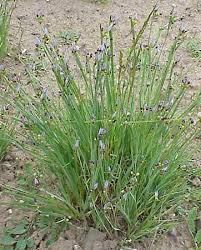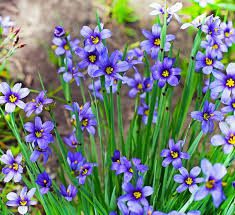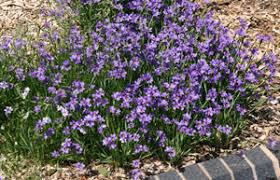Blue Eyed Grass or Sisyrinchium angustifolium is a pretty plant with thin leaves and small flowers. It’s not really a grass, but it looks like one. The flowers are blue or purple and have a yellow middle that looks like eyes.
This plant grows in North America in places like fields and near water. It doesn’t need too much care. Plant it in soil that drains well and put it where it can get sunlight. Water it sometimes, but not too much.
When spring and early summer come, blue eyed grass makes its flowers. These flowers are good for butterflies and other bugs that help plants grow. After the flowers, small round things with seeds inside grow. These seeds make sure more plants can grow later on.
In short, blue eyed grass is a nice plant that makes small blue or purple flowers. It helps bugs like butterflies and is easy to take care of. It grows in North America and makes seeds for the future. It’s a simple way to make a garden look pretty and help nature at the same time.
Read Also: Description of Some Popular Goat Breeds
Growing and Care Guide of Blue Eyed Grass

Blue eyed grass (Sisyrinchium angustifolium) is an appealing plant that’s quite simple to grow and care for. Follow these steps to enjoy its delicate beauty in your garden:
1. Choosing the Right Spot: Find a sunny spot in your garden or yard where the blue eyed grass can get at least 6 hours of sunlight each day. This will help it grow strong and produce beautiful flowers.
2. Preparing the Soil: Make sure the soil drains well. You can test this by digging a small hole and filling it with water. If the water drains away within a few hours, the soil is good. If it stays there, you might need to improve drainage by adding sand or compost.
3. Planting: You can plant blue eyed grass from seeds or young plants. If using seeds, sow them in the spring or fall. If using young plants, plant them in the soil, leaving about 6 to 8 inches of space between each plant.
4. Watering: While blue eyed grass doesn’t need a lot of water, it’s important to keep the soil evenly moist during the growing season. Water the plants when the top inch of soil feels dry to the touch.
5. Mulching: Adding a layer of mulch around the plants can help retain moisture and prevent weed growth. Use organic mulch like straw or wood chips.
6. Fertilizing: Blue eyed grass doesn’t require much fertilizer. A balanced, all-purpose fertilizer can be applied in the spring to give the plants a little boost.
7. Pruning: After the flowers have bloomed and the seed capsules have formed, you can cut back the spent flower stalks. This tidies up the appearance of the plant and helps encourage new growth.
8. Dividing: Over time, blue eyed grass can become crowded. To keep it healthy, you can divide the plants every few years. Dig up the clumps, gently separate them into smaller sections, and replant them.
9. Pest and Disease Control: Blue eyed grass is generally resistant to pests and diseases. However, keep an eye out for slugs or snails, especially if your area tends to have these pests.
10. Attracting Pollinators: Blue eyed grass flowers are attractive to pollinators like butterflies and bees. Having these beneficial insects around will help your garden thrive.
Remember, blue eyed grass is a native plant, so it naturally adapts to its environment. By following these simple steps, you can enjoy the beauty of blue eyed grass while contributing to a healthier garden ecosystem.
Environmental Impact of Blue Eyed Grass

The environmental impact of blue eyed grass (Sisyrinchium angustifolium) is predominantly positive, as this native plant contributes to the local ecosystem in various ways:
1. Biodiversity: Blue eyed grass provides a food source for pollinators such as butterflies, bees, and other beneficial insects. By attracting these pollinators, the plant supports biodiversity and helps in the reproduction of other flowering plants in the area.
2. Wildlife Habitat: The plant’s flowers and seeds attract birds and small mammals, creating a habitat that contributes to the overall health of the ecosystem. These animals rely on blue eyed grass for food and shelter.
3. Soil Health: Blue eyed grass has a relatively shallow root system, which helps prevent soil erosion by stabilizing the topsoil. Its presence can improve soil structure and fertility over time.
4. Native Plant Conservation: Planting blue eyed grass helps preserve native plant species in their natural habitats. As a native plant itself, it plays a role in maintaining the delicate balance of the local ecosystem.
5. Reduced Maintenance: Blue eyed grass is well-suited to its native environment and requires minimal care once established. Its low water and fertilizer needs contribute to water conservation and reduce the use of synthetic chemicals.
6. Carbon Sequestration: Like all plants, blue eyed grass absorbs carbon dioxide from the atmosphere during photosynthesis, contributing to carbon sequestration and helping mitigate the effects of climate change.
7. Educational Value: Blue eyed grass serves as an educational tool to raise awareness about native plants and their importance in local ecosystems. Learning about and cultivating native plants can lead to more environmentally conscious gardening practices.
8. Aesthetic Enhancement: Beyond its ecological contributions, blue eyed grass adds natural beauty to gardens, landscapes, and natural areas. Its charming blue or purple flowers and grass-like foliage enrich the visual appeal of outdoor spaces.
It’s important to note that when introducing blue eyed grass into a new environment, care should be taken to avoid potential negative impacts, such as displacing native plant species or altering natural ecosystems. Native plant gardening and habitat restoration projects often prioritize the use of plants like blue eyed grass to support local biodiversity and maintain a healthy balance within ecosystems.
Read Also: General Principles of Goat Production
Benefits and Uses of Blue Eyed Grass

Blue eyed grass (Sisyrinchium angustifolium) offers a range of benefits and uses, both for the environment and for those who appreciate its unique qualities:
1. Pollinator Attraction: The vibrant blue or purple flowers of blue eyed grass are a magnet for pollinators, including butterflies, bees, and other beneficial insects. By attracting these pollinators, the plant aids in the pollination of other nearby plants, contributing to overall ecosystem health and biodiversity.
2. Wildlife Habitat: Blue eyed grass provides a source of food and shelter for birds, small mammals, and insects. Its seeds and flowers attract various wildlife, creating a habitat that supports a diverse array of creatures.
3. Native Plant Landscaping: Incorporating blue eyed grass into gardens and landscapes helps create a more natural and sustainable environment. Native plants like blue eyed grass are well-suited to local conditions, requiring less water, fertilizer, and maintenance compared to non-native species.
4. Erosion Control: Blue eyed grass has a fibrous root system that helps stabilize soil and prevent erosion. Planting it on slopes or areas prone to soil erosion can help protect the landscape and maintain soil structure.
5. Educational Value: Blue eyed grass serves as an educational tool for teaching about native plant species, their role in ecosystems, and the importance of supporting biodiversity. Its presence in educational gardens and nature centers can help raise awareness about local flora and fauna.
6. Aesthetics: Blue eyed grass adds a touch of beauty and charm to outdoor spaces. Its delicate flowers and grass-like foliage provide visual interest and create a natural, tranquil atmosphere.
7. Medicinal and Cultural Uses: Historically, some Native American tribes used blue eyed grass for medicinal purposes, although its use in modern herbal medicine is limited. It also holds cultural significance for some Indigenous communities.
8. Cut Flowers: The striking blue or purple flowers of blue eyed grass can be cut and used in floral arrangements, adding a unique and eye-catching element to bouquets.
9. Naturalization and Restoration: Blue eyed grass can be used in habitat restoration projects to reestablish native plant communities. It aids in restoring areas that have been disturbed by human activity or invasive species.
10. Low-Maintenance Gardening: For gardeners seeking low-maintenance options, blue eyed grass is an ideal choice. Its adaptability and minimal care requirements make it an attractive addition to any garden, from residential yards to public spaces.
Incorporating blue eyed grass into landscapes and gardens not only enhances the visual appeal of outdoor areas but also contributes to ecological balance, supports local wildlife, and promotes sustainable gardening practices.
Read Also: Composting Equipment: What You Need to Know
